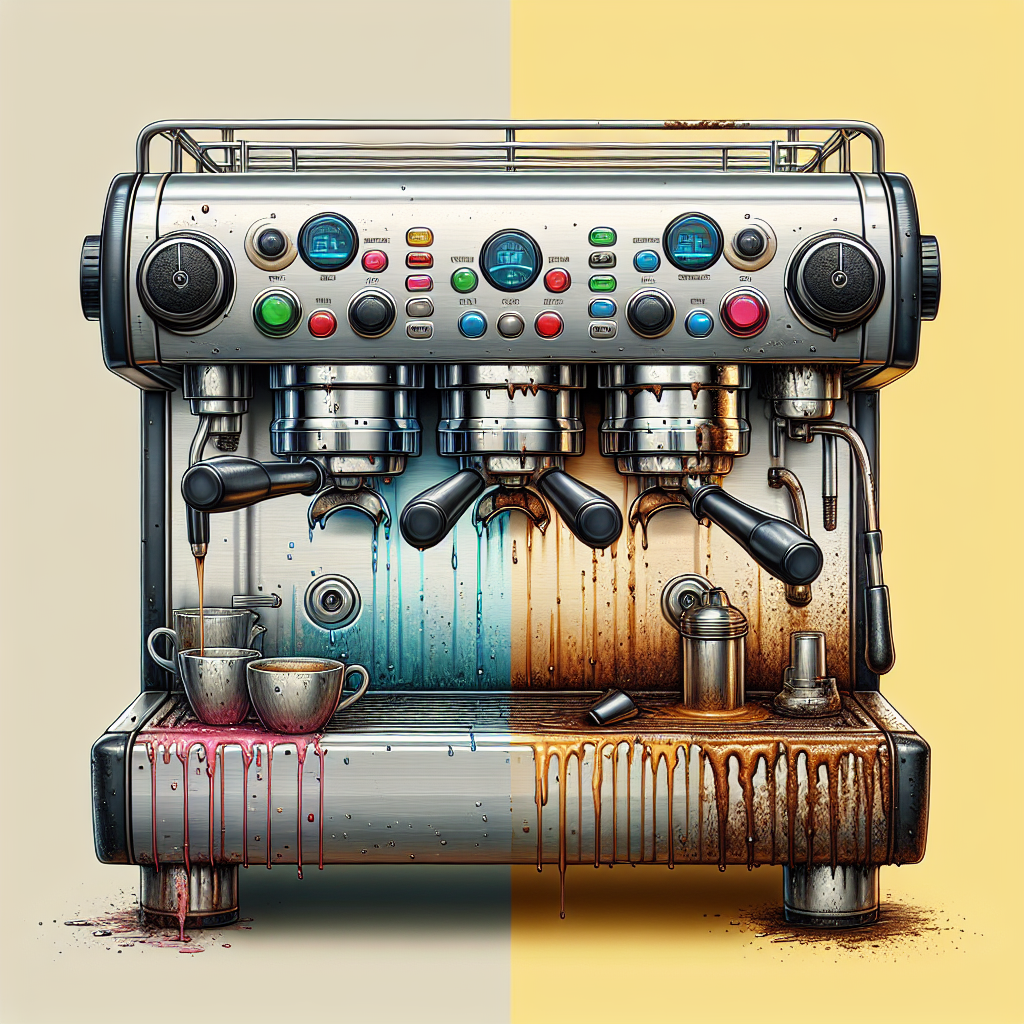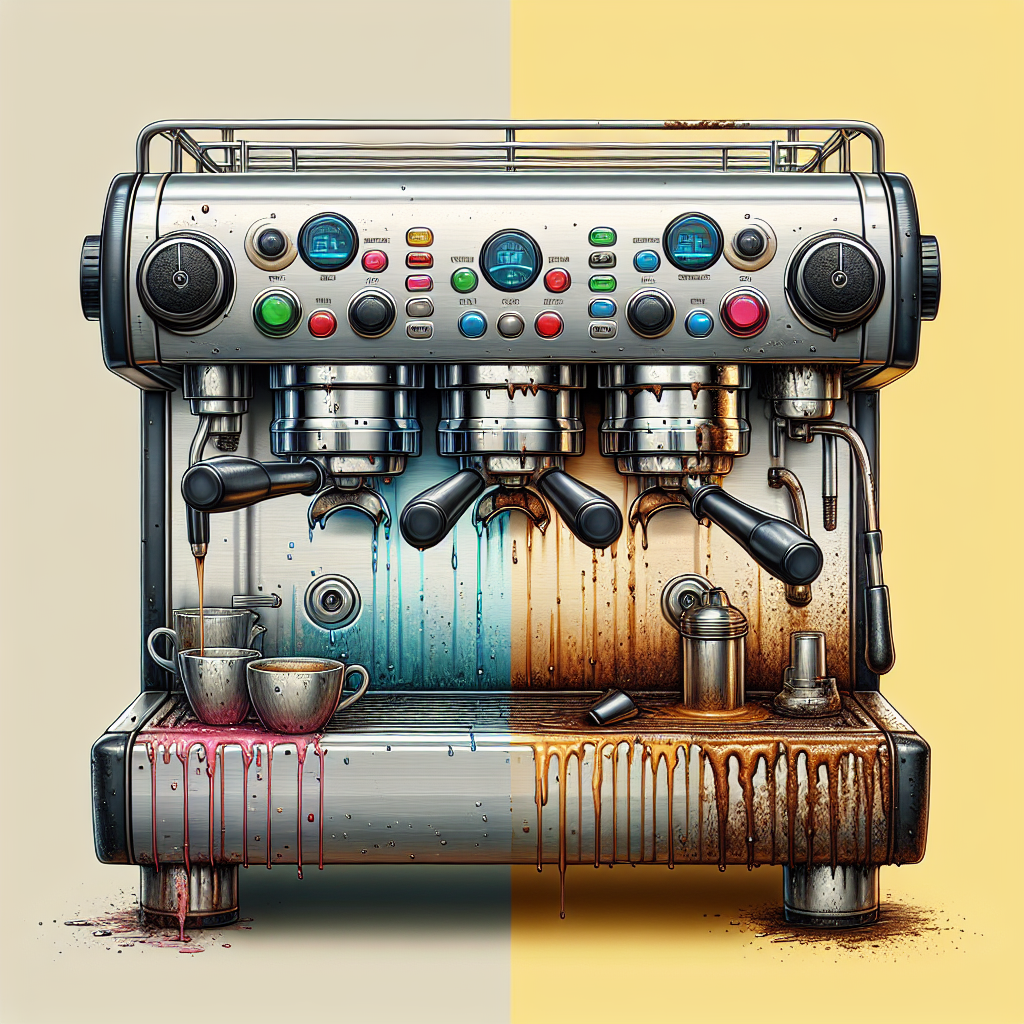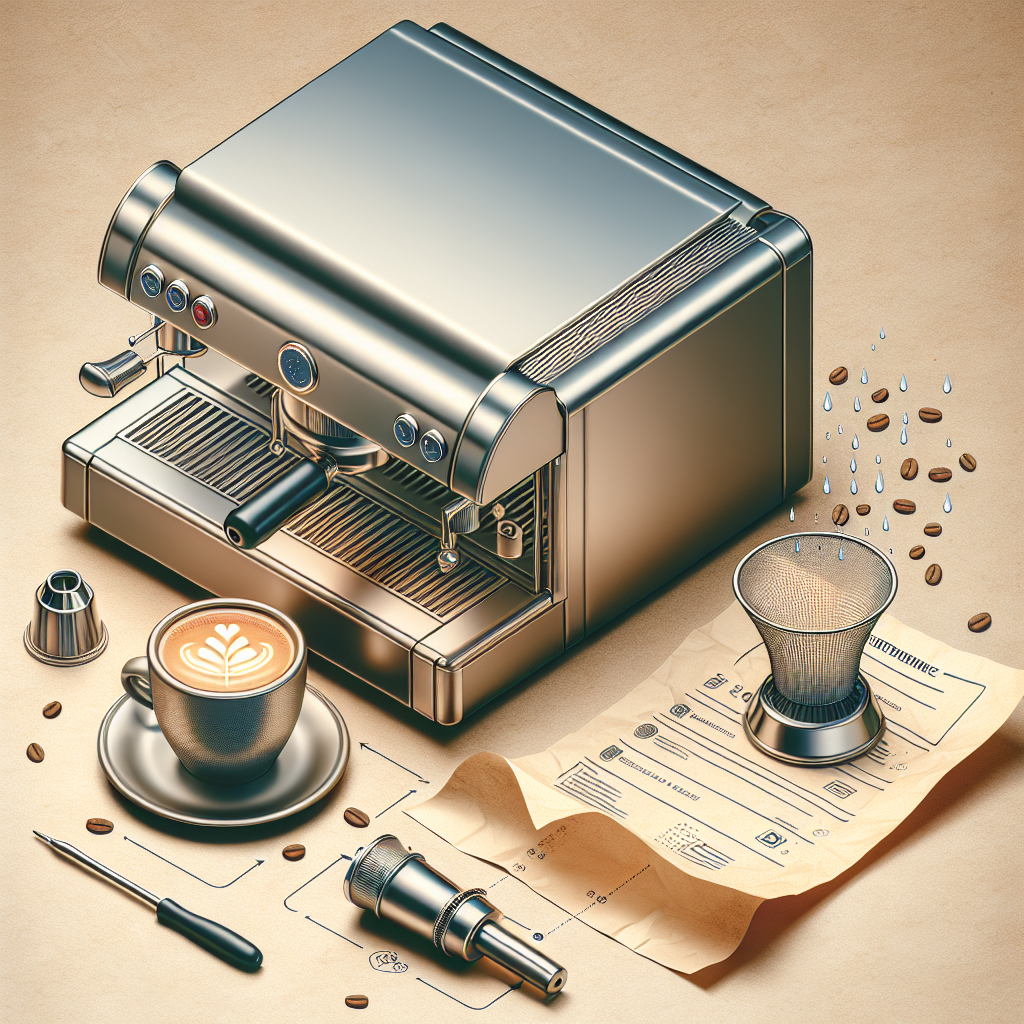
Stainless steel espresso machines are a sleek and sophisticated addition to any kitchen, but like any appliance, they can sometimes encounter common issues. In this article, you will discover a helpful guide on troubleshooting these problems, allowing you to get back to enjoying your daily dose of caffeinated goodness in no time. From addressing water leaks to troubleshooting temperature fluctuations, we’ve got you covered with easy-to-follow tips and tricks. So, grab your favorite mug and let’s delve into the world of stainless steel espresso machine troubleshooting together!
Power Issues
Machine not turning on
If your stainless steel espresso machine is not turning on, the first thing you should check is the power source. Ensure that the machine is properly plugged into a functioning outlet. If it is plugged in correctly and still not turning on, try resetting the circuit breaker or checking if the power switch on the machine is in the “on” position.
Power cord is damaged
If the power cord of your espresso machine is damaged, it can prevent the machine from turning on. Inspect the cord for any visible damage such as frayed wires or exposed insulation. If you notice any damage, it is crucial to replace the power cord immediately to avoid any electrical hazards.
Fuse blown
If your espresso machine suddenly stopped working and even the power indicator light is off, it could be due to a blown fuse. To fix this issue, locate the fuse compartment on your machine (usually located near the power cord) and check if the fuse is blown. If it is, replace it with a new fuse of the same rating. However, if the fuse continues to blow, it may indicate a more significant electrical problem, and it is recommended to consult a professional technician.
Water Flow Issues
No water coming out
If your espresso machine is not delivering any water, the first thing you should check is the water tank. Ensure that it is filled to the appropriate level and properly connected to the machine. Additionally, check if the water filter or water lines are clogged. If so, clean or replace them accordingly.
Weak water flow
If the water flow from your espresso machine is weak, it could be due to a clogged water filter or mineral buildup in the machine. Start by cleaning the water filter and removing any debris or residue. If the issue persists, descale your machine using a descaling solution specifically designed for espresso machines. This will help remove any mineral buildup and restore proper water flow.
Water leaking from machine
If you notice water leaking from your stainless steel espresso machine, it could indicate a problem with the water reservoir or the water lines. Check if the water reservoir is properly seated and not overflowing. Inspect the water lines for any signs of damage or looseness. If the issue persists, it is recommended to contact the manufacturer or a professional technician for further assistance.

Steam Issues
No steam coming out
If your espresso machine is not producing steam, it is likely due to an issue with the steam wand or the boiler. First, ensure that the steam wand is properly attached and not clogged. Clean it thoroughly to remove any milk residue or blockages. If the steam wand is functioning correctly, the problem may lie with the boiler. In this case, it is advisable to contact a professional technician for repairs.
Weak steam pressure
If the steam pressure from your espresso machine is weak, it could be due to mineral buildup in the steam wand or boiler. Start by descaling the machine using a descaling solution as per the manufacturer’s instructions. This will help remove any mineral deposits and restore proper steam pressure. If the issue persists, it may require professional servicing.
Steam leaking from machine
If you notice steam leaking from your espresso machine, it could indicate a problem with the steam valve or the steam wand gasket. Check if the steam valve is tightly closed and not leaking. Additionally, inspect the steam wand gasket for any signs of wear or damage. If necessary, replace the gasket to prevent further steam leaks.
Temperature Issues
Water not heating up
If the water in your espresso machine is not heating up, it could be due to a faulty heating element or thermostat. Check if the heating element is properly connected and not damaged. If the element appears to be in working order, it may indicate a problem with the thermostat. In such cases, it is recommended to seek professional assistance for repair or replacement.
Water overheating
If the water in your espresso machine is overheating, it could be due to a malfunctioning thermostat or temperature sensor. Check the temperature settings on your machine and ensure they are at the appropriate level. If the issue persists, it is advisable to contact the manufacturer or a professional technician for further diagnosis and repair.
Inconsistent temperature
If your espresso machine is unable to maintain a consistent water temperature, it can adversely affect the flavor and quality of your espresso. This issue could be caused by a faulty thermostat, temperature sensor, or heating element. It is recommended to have a professional technician inspect and repair the machine to ensure optimal temperature consistency.

Grinding Issues
Inconsistent grind size
If you notice inconsistent grind sizes in your espresso machine, it could be due to a problem with the grinder settings or blades. Check the grinder settings and adjust them accordingly to achieve the desired grind size. If the issue persists, it may indicate a need to clean or replace the grinder blades.
Machine not grinding coffee
If your espresso machine is not grinding coffee beans, it could be due to a clogged grinder or a malfunctioning grinder motor. Start by cleaning the grinder and removing any coffee residue or debris. If the problem persists, it may require professional servicing or replacement of the grinder motor.
Grinder clogged
If the grinder in your espresso machine is clogged, it can affect the quality of your coffee extraction. Clean the grinder regularly to remove any stuck coffee grounds or oily residue. It is recommended to follow the manufacturer’s instructions for cleaning and maintenance or consult a professional technician for assistance.
Crema Issues
No crema forming
If your espresso machine is not producing crema, it could be due to various factors such as improper coffee tamping, incorrect grind size, or low-quality coffee beans. Ensure that you are using freshly roasted and properly ground coffee beans. Adjust the grind size and tamp the coffee evenly and firmly to promote crema formation. If the issue persists, it may be helpful to consult a barista or coffee expert for further guidance.
Thin and weak crema
If the crema produced by your espresso machine appears thin and weak, it could be due to a low coffee extraction pressure or improper coffee tamping. Check if your machine’s extraction pressure is within the recommended range. Additionally, ensure that you are tamping the coffee evenly and with the appropriate amount of pressure. These adjustments can help improve the quality and thickness of the crema.
Excessive crema
If your espresso machine produces excessive crema that overflows from the cup, it could be due to an incorrect coffee dosage or a grind size that is too fine. Adjust the coffee dosage and grind size to ensure the proper extraction. It may require some trial and error to find the ideal balance for achieving a balanced and flavorful espresso shot without excessive crema.
Cleaning and Maintenance Issues
Machine not descaling
Descaling is an essential maintenance task for your stainless steel espresso machine to remove mineral deposits and ensure optimal performance. If your machine is not descaling, it could be due to a malfunctioning descaling program or a clogged descaling nozzle. Check the machine’s manual for proper descaling instructions and ensure that the descaling program is functioning correctly. If the issue persists, it may require professional servicing.
Coffee stains and residue
Coffee stains and residue can accumulate over time, affecting the appearance and taste of your espresso. Regularly clean your machine’s exterior surfaces and parts using mild detergent and a soft cloth. For stubborn stains, use a non-abrasive cleaner or a mixture of vinegar and water. Proper cleaning and maintenance will help prevent buildup and preserve the aesthetic appeal of your espresso machine.
Group head clogged
If the group head of your espresso machine is clogged, it can impact the water flow and overall extraction quality. Remove the portafilter and inspect the group head for any visible debris or blockages. Use a brush specifically designed for cleaning espresso machines to remove any residue or coffee grounds. Regular cleaning and maintenance of the group head are essential for ensuring consistent and flavorful espresso shots.
Sudden Stops and Error Messages
Machine stops during brewing
If your espresso machine stops in the middle of the brewing process, it could be due to various factors such as a clogged filter basket, a malfunctioning pump, or an error in the machine’s programming. Start by checking if the filter basket is properly seated and not clogged with coffee grounds. If the issue persists, it may require professional diagnosis and repair.
Error message on display
If your espresso machine displays an error message, consult the machine’s manual for the specific error code and troubleshooting steps. Common error messages can indicate problems with the water level, temperature, or other internal components. Follow the manufacturer’s instructions for resolving the error message, and if needed, contact their customer support for further assistance.
Pump not working
If the pump of your espresso machine is not working, it can prevent proper water pressure and extraction. Check if the pump is properly connected and not clogged with debris. Additionally, inspect the water lines for any signs of damage or blockages. If the pump continues to malfunction, it is recommended to seek professional servicing for repairs or replacement.
Noise and Vibration Issues
Loud noise during operation
If your espresso machine produces loud noise during operation, it could be due to a malfunctioning motor, pump, or grinder. Noise from the motor or pump may indicate the need for lubrication or replacement. A loud grinding noise can indicate issues with the grinder assembly, such as misalignment or worn-out components. It is advisable to consult a professional technician for proper diagnosis and repair.
Excessive vibrating
Excessive vibration from your espresso machine during operation can be disconcerting and indicate loose or misaligned components. Start by checking if the machine is placed on a stable surface and not in direct contact with other objects. Inspect the machine’s internal parts for any loose screws or bolts and tighten them as necessary. If the excessive vibration persists, it may require professional attention.
Grinding noise from grinder
If your espresso machine’s grinder emits a grinding noise during operation, it could be due to a misaligned or damaged grinder assembly. Turn off the machine and inspect the grinder for any visible signs of misalignment or wear. Clean the grinder and ensure that all components are properly fitted. If the grinding noise persists, it is recommended to seek professional servicing or replacement of the grinder assembly.
Accessories Issues
Portafilter not fitting properly
If your espresso machine’s portafilter does not fit properly, it can affect the quality of your espresso extraction. Ensure that the portafilter is clean and free from any coffee grounds or residue. Check if the machine’s group head gasket is intact and not worn out. If necessary, replace the gasket or consult a professional technician for further assistance.
Tamper not working correctly
A properly functioning tamper is essential for achieving consistent espresso shots. If your tamper is not working correctly or feels loose, it may indicate a problem with the tamper itself or the portafilter. Check if the tamper is the correct size for your portafilter and ensure that it fits snugly. If the issue persists, consider replacing the tamper or consulting a barista for guidance on proper tamping technique.
Coffee basket stuck
If the coffee basket of your espresso machine gets stuck, it can be frustrating and hinder your brewing process. The most common cause of a stuck coffee basket is the buildup of coffee grounds or residue. Remove the portafilter and inspect the coffee basket for any obstructions. Use a brush or a toothpick to dislodge any stuck coffee grounds. Regular cleaning and maintenance of the coffee basket will help prevent future occurrences of this issue.
By troubleshooting these common issues with your stainless steel espresso machine, you can ensure optimal performance and enjoy delicious espresso! Remember to follow the manufacturer’s instructions for cleaning, maintenance, and any warranty-related procedures. If the issues persist or seem beyond your ability to troubleshoot, do not hesitate to contact the manufacturer’s customer support or seek professional assistance. Happy brewing!